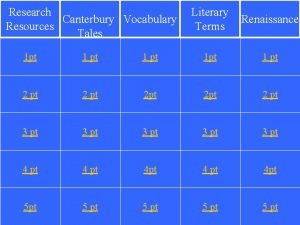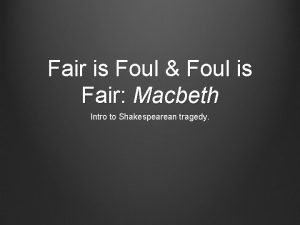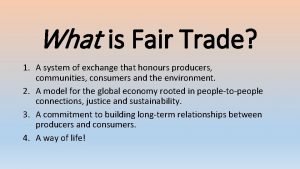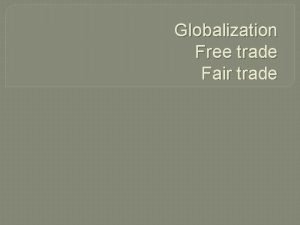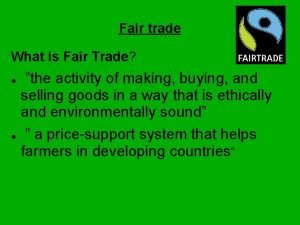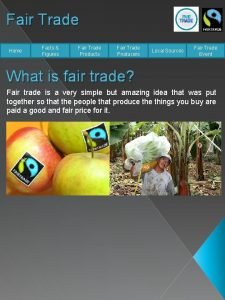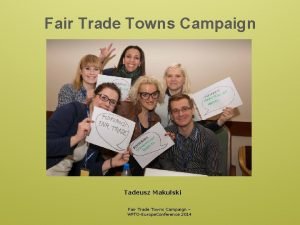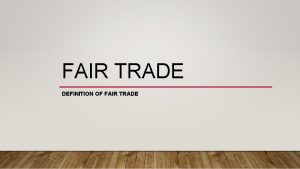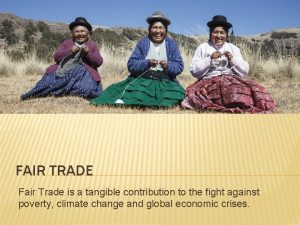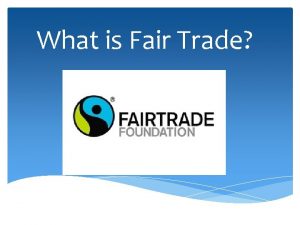Fair Trade Fair Trade Fair Trade is all









- Slides: 9

Fair Trade

Fair Trade • • Fair Trade is all about making sure the people that grow or make things we buy get a fair price for what they do Often it is the people far away who grow foods, such as cocoa beans for your bar of chocolate, who are the ones who get the worst deal from what you buy. Instead, it is the big international companies and advertising agencies who take most of the profits. Oxfam is working to get international companies to pay fair prices to the people who make and grow the things we buy. This includes farmers, craftsworkers and other producers, all over the world. We are also persuading supermarkets that customers want producers to be paid a fair price

Fair Trade Bananas • After a long campaign, supermarkets started selling Fair Trade bananas. These bananas cost a bit more than other bananas, but by buying them you know that the people who grew them get a good deal. That must be worth the extra cash!

1. The Journey of the Banana • Growing bananas is hard work. It takes months to clear the land, dig holes and put in banana plants. After about six months, the banana fruit begins to appear. At an early stage the growing bananas are wrapped in blue plastic. This stops the fruit from getting damaged. It also protects the fruit against pesticides that are sprayed on the plants.

2. Freshly cut bananas • After nine months, the bananas are harvested using a sharp knife. Bananas are still green when they are picked. • They grow in clusters, which are known as 'hands'. A hand consists of 10 to 20 bananas, also called fingers.

3. Labelling the bananas • Bananas are washed and labelled before being put into boxes. • Bananas are boxed on the banana farms where they are produced. This prevents them getting bruised.

4. Sorting bananas at the warehouse • Bananas are taken from the farm to a warehouse in a truck. At the warehouse they are inspected and sorted. • Buyers of fruit in the UK want unbruised bananas and so very high standards are set. If the bananas do not meet these standards they are sold locally at a much lower price. • After the inspection the boxes are closed and weighed

5. Loading bananas onto a ship • Bananas take six days to get from the Windward Islands, a small group of islands in the southern part of the Caribbean Sea, to the UK. • They are stored in the ship's hold which is refrigerated at 13. 3°C. This cool temperature prevents them from ripening. • When the bananas reach the UK they are ripened in special centres and then sent to the shops.

6. Fair Trade bananas on sale • On average each person in the UK eats 10 kg bananas a year. A lot of bananas! • If you buy bananas from the Windward Islands, you will help small farmers. Buying fair trade bananas will also mean that the people who grow them get paid a fair price.
 Fair trade not free trade
Fair trade not free trade Name three lines
Name three lines 14 lines of shakespeare
14 lines of shakespeare Foul is fair and fair is foul literary device
Foul is fair and fair is foul literary device Examples of alliteration in macbeth
Examples of alliteration in macbeth Who says fair is foul and foul is fair
Who says fair is foul and foul is fair Rhetorical devices syntax
Rhetorical devices syntax Significato fair play
Significato fair play Examples of fair is foul and foul is fair in macbeth
Examples of fair is foul and foul is fair in macbeth Is free trade fair? discuss
Is free trade fair? discuss



